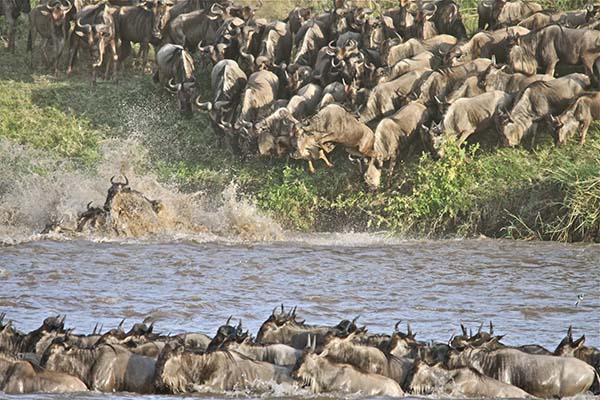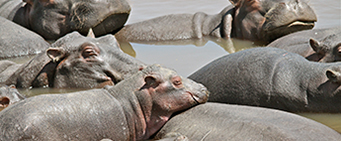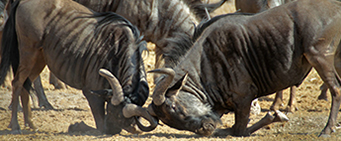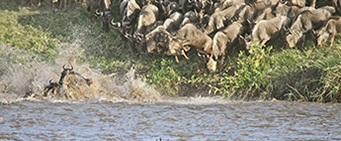The migration is more than wildebeest, certainly they assume the lead role with some 1.5 million. There are also some 350,000 Thomson’s gazelle, 200,000 zebra and 12,000 eland. Moving around approximately 40,000 square kilometres in the Mara and Serengeti eco systems, the migration is not one single herd or movement and there is no start nor end, it’s a constant search for food and water. The only beginning is the moment of birth. An estimated 300,000 – 400,000 wildebeest calves are born during a two week period each year between late January and mid March when optimum grazing is available on the short grass plains at the base of the Gol Mountains.
From here, the highly complex natural phenomenon of the Great Migration continues, with over two million herbivores moving and grazing across the Serengeti-Mara ecosystems creating the greatest wildlife spectacle in the world. The migration path varies from year to year depending on weather and other environmental factors that impact upon the quality and availability of grazing land and water. The wildebeest migration can be seen in Kenya’s Masai Mara or Tanzania’s Serengeti at different times of the year.
A Migration Safari is the chance to see great wildebeest herds and other herbivores plus the predator action that occurs. The wildebeest are continuously moving and predators are not able to keep up because they are territorial and don’t want to risk abandoning their land or invading the regions of others. The young of predators are also more dependent upon their mothers so they cannot risk great durations or distances of separation.

In Masai Mara, watching numerous crossings of the Mara River by wildebeest and zebras. But even more incredible was an elephant crossing in a deep section of river and the way in which the mature elephants formed around the juveniles to keep them afloat and protect them against croc attack.

When to Go
Now that all depends on what component of the Migration you wish to see. The precise timing of the wildebeest migration is weather dependent – so it is all based on rainfall patterns as the animals prefer short grass, fresh and nutritious. If we start with birth – the herds head in November/December to the southern Serengeti Ndutu area to graze on the new grass growth and form stronger numbers for protection because in February they almost all have had their young. It’s then time to move again by March when they head west. April through to June they slowly move north and pause at the Grumeti River in the Western Corridor. July they spread throughout the north area and it’s usually between August and September you see the famous Mara river crossings. Time is spent in the Masai Mara before moving south once more returning for the fresh green shoots from short rain.

Good to Know
The Migration is simply one moving herd of animals. There is a main herd, the largest in size and sub-herds and often they spread out over vast areas, even both sides of the Mara River. We always recommend spending time in two different locations to maximise your chance of seeing the herds. You will also see more than just the migrating animals and predators. The resident game are also a sight to see, especially hippo in the lakes and waterholes. Accommodation options vary from adventure style tented camps, luxury camps to luxury lodges and a handful of larger hotel chain style properties. It’s always ideal to have your own private professional guide and vehicle so you can go wherever the wildlife takes you. When sharing vehicles, you have to negotiate and compromise with the wants and desires of other travellers.
Browse our Itinerary Collection for Wildebeest Migration Safari inspiration
Overall the trip was of course a fantastic experience! In short, the highlight would be the Serengeti – waking up to the wildebeest migrating 50m from our tent is probably a once in a lifetime experience!
In Masai Mara, watching numerous crossings of the Mara River by wildebeest and zebras. But even more incredible was an elephant crossing in a deep section of river and the way in which the mature elephants formed around the juveniles to keep them afloat and protect them against croc attack.
Want to know what others said? Read all our customer ovations.
Get in touch today so we can customise a Wildebeest Migration Safari holiday for you.






